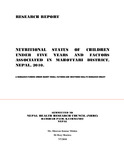Please use this identifier to cite or link to this item:
https://hdl.handle.net/20.500.14356/777| Title: | Nutritional Status of Children under Five Years and Factors Associted in Mahottari District, Nepal, 2010 |
| Authors: | Mishra, Shravan Kumar Sharma, Rosy |
| Issue Date: | 7-Jul-2010 |
| Keywords: | Nutritional Status |
| Abstract: | Protein energy malnutrition (PEM) is chronic public health problem in Nepal. The population of under five children in Nepal constitutes more than ten per cent of total population. Socio-economic and environment factors are found to be significant for malnutrition among children under five. In the mid-southern Terai including Mahottari district has protein energy malnutrition and micronutrient deficiencies problem due to behavioral and socio-cultural problems. The study was conducted to assess the nutritional status of under five children in Mahottari district of Nepal by considering socioeconomic and demographic factors and taking anthropometric measurements. The study was cross sectional and descriptive. The study included 400 children selected randomly 9 from each 45 wards which in turn selected from 15 sample village development committees (VDCs) selected from of 77 VDCs three clusters which comprised two electoral constituencies each from 6 electoral constitutions of Mahottari district. All clusters were designed on the basis of population and sample was fixed proportionally from each cluster. The socio-cultural and household indicators of people of Mahottari district showed poor in relation to nutrition. The mid upper arm circumference (MUAC) showed half of the children were protein energy malnourished. Among PEM children, 11% were severely malnourished. According to Gomez classification, the two third of children were malnutrition which comprised of 16% severe, 25% moderate and 28% mild malnutrition. The Waterlow’s classification revealed that two-third of children were suffering from acute and chronic malnutrition which comprised of 22% stunted indicating chronic malnutrition, 29% wasted indicating acute malnutrition and 14% wasted and stunted showing chronic and acute malnutrition. The bivariate analysis showed not significant (p=0.07 for underweight and p=0.79 for stunting) relationship of sex, ethnicity (p=0.46 for underweight and p=0.23 for stunting), and household economic status (p=0.69 for underweight and p=0.35 for stunting) with nutritional status of children. Significant association was observed between age of the children (p=0.00 for both underweight and stunting), mothers’ education (p=0.004 for underweight and p=0.002 for stunting), and use of rice scum at household (p=0.04 for underweight and p=0.04 for stunting) and nutrition status of children. |
| URI: | http://103.69.126.140:8080/handle/20.500.14356/777 |
| Appears in Collections: | Post Graduate Grant (PG) Reports |
Items in DSpace are protected by copyright, with all rights reserved, unless otherwise indicated.

